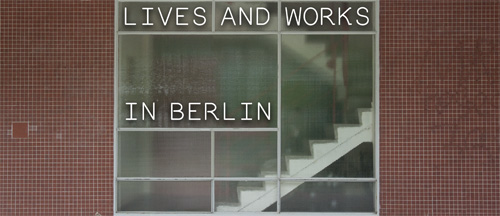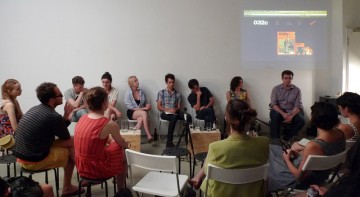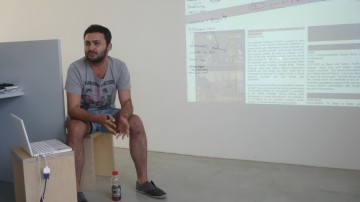… and put your car on cruise and lay back cause this is summertime
— Will Smith
Berlin summers never fail to deliver their own magical moments, the kind that make you remember why you’re here, why you chose this place. Perhaps these moments are more pronounced because the memory of Berlin winters (and this previous one in particular) make one soak up all the sun, the heat, the colors, the grass, the night-swimming, the sunrises by the canal, the sunsets in the park, the days by the lake and the impromptu studio barbeques with an urgency that can only exist in places where these things are luxuries, and fleeting ones.
Berlin summers never fall short of art tourists either, and this year is no exception — the city is full with internationals stopping in anywhere from a weekend to three months to enjoy what’s best about it — the perks of being simultaneously an art world hub and the so-called “slacker capital of the world.” There are, however, some visitors who have gather no moss. During the three weeks of programming that New York’s Triple Canopy put together this month in collaboration with Program Gallery and Nine Eglantine Yamamoto-Masson, there was simply no time for lazy summer activities. Triple Canopy facilitated six evenings, most consisting of multiple events such as podium discussions, artist’s performances, dinners, workshops and topics, reflecting their collaborative organizational approach.
On July 22, “Print and Demand” — one of the events in the series — brought together editors and representatives of four publications for a podium discussion on the changing nature of print and online publishing. Participants included the Norway-based XYM ,whose content is solely downloadable in pdf form, Berlin-based bi-annual publication 032c, the Canadian art magazine/journal Fillip and Triple Canopy’ s several associated web-based publications. Given the diverse nature of the participants, formats, readership, and funding models (including “no” budget, public grants, and traditional ad-based financing), the discussion was lively and fortunately not heading towards a print vs. digital polemic (which would have been really boring). The panel members offered a unified response to a question from the audience about missing comment functions or ways that readers could respond to the content of the publications; interestingly, none of the participants encourage this type of anonymous feedback. Panel members agreed that their readership and contributors often overlap – instead of writing comments or letters to the editor, readers with ideas should think about contributing. They also pointed out that they all thought of their respective projects as curating spaces which can affect “community building”– no matter whether these communities coagulate through websites, downloadable pdfs or within a magazine format purchased in art bookstores or newsstands.
One of the ways that curator Adnan Yildiz speaks about his own curatorial practice is in the role of a “blogger.” He recently launched the website for his upcoming project Correct Me If I’m Critical, hosted by the Swedish embassy of Berlin in collaboration with several Berlin spaces and institutions, which will reflect the process of the exhibition with ongoing changes and new posts on related events and issues. Even though the exhibition doesn’t open until September 12, on June 13, “Critical Sunday” – a one-day event at the Nordic Embassies’ Felleshus – represented the project’s launch. This included a solo presentation by Romanian-born artist Daniel Knorr, a lecture by the collective Slavs and Tatars, and discussions on the possible presence of a “Berlin style” (in terms of artist-curator relationships and exhibition-making). The question of definable characteristics of Berlin exhibitions (or a common curatorial “grammar,” as Yildiz calls it) is interesting also in terms of local politics. At the moment, the city of Berlin tries hard to brand itself in a certain way, focusing heavily on its creative potential with the “Be Berlin” campaign. The campaign has been running for about 15 months now, and yet no one is quite sure what “Be Berlin” is supposed to… mean… or exclude? Can you not “Be Berlin”?
But back to exhibition-making. In his talk, “Summertime” (no relation to the hit single as far as I know), which took place on July 28 at Galerie Opdahl, Yildiz spoke about his ideas behind planning an exhibition with “critical” artists, and what that can entail. While the type of artistic criticality he is hinting at certainly has serious undertones — for example in terms of social critique — Yildiz also uses the word fully aware of its alternative meanings (such as a “critical” alcohol level after a party or a “critical” deadline in planning the exhibition). And so Correct Me If I’m Critical, whilst not being ironic about the issues it touches upon, also becomes a play on words that does not take itself too(ooo) seriously and leaves room for alternate interpretations.
An essential aspect of the show will be the collaboration and connection between different institutions and venues in Berlin – something that happens all too seldom in the city. The two main venues of Correct Me If I’m Critical, the Nordic Embassies’ Felleshus / Pan Nordic Building and the café/gallery space NEST, might be seen as two possibilities at opposite ends of the spectrum of exhibition spaces. These two main venues are accompanied by three “attachements,” as Yildiz calls them: Galerie Opdahl, Supportico Lopez, and Program Gallery, which will host three respective solo projects by artists Viron Vert @ Galerie Opdahl, Nilbar Güreş @ Supportico Lopez, and Markus Degerman @ Program Gallery.
With the exhibition largely taking place in the district of Kreuzberg, Yildiz is careful to point out that he will not be “bringing” art to new spaces currently used in other ways. Should we read this as an intentional gesture that stands in contrast to the approach of such events as the current Berlin Biennale, which is largely “re-using” spaces in Kreuzberg previously empty or being used for non-art events? Yildiz does not step into the Fettnäpfchen of making some obvious statement about gentrification (as those living in Kreuzberg have heard so many times) by positioning himself on either side of the sometimes harshly drawn line between old and new local factions. Like many of Kreuzberg’s residents, he is neither a new arrival to the area or an old squatter of a factory building. Nor does he pretend to be.
German-born Anna Milandri is an artist currently based in Berlin, where she recently completed her MA. Her research interests include 19th century landscape garden architecture, early optical devices and anthroposophic cults of the Pacific Northwest.







Pingback: From Commenting to Contributing, via Berlin | View on Canadian Art
Pingback: review at art:21 « correct me if i'm critical